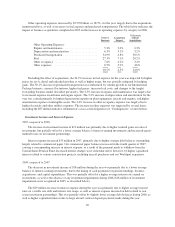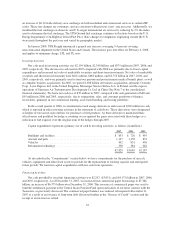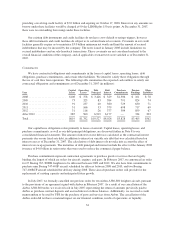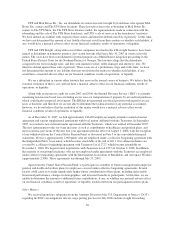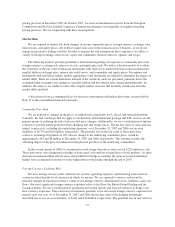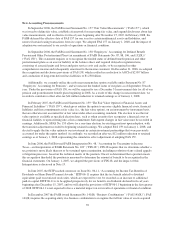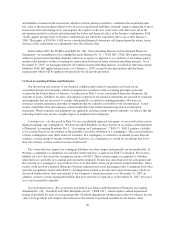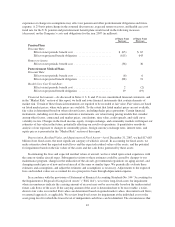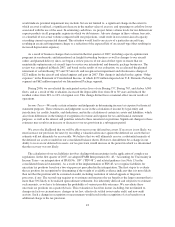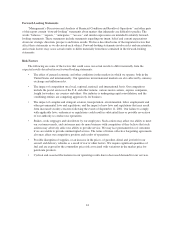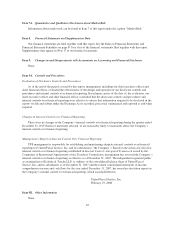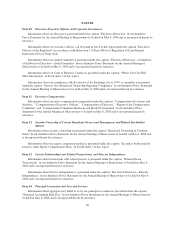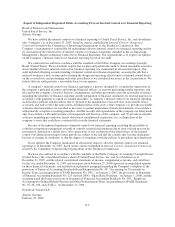UPS 2007 Annual Report Download - page 55
Download and view the complete annual report
Please find page 55 of the 2007 UPS annual report below. You can navigate through the pages in the report by either clicking on the pages listed below, or by using the keyword search tool below to find specific information within the annual report.and liabilities assumed in the transaction (whether a full or partial acquisition); establishes the acquisition-date
fair value as the measurement objective for all assets acquired and liabilities assumed; requires expensing of most
transaction and restructuring costs; and requires the acquirer to disclose to investors and other users all of the
information needed to evaluate and understand the nature and financial effect of the business combination. FAS
141(R) applies prospectively to business combinations for which the acquisition date is on or after January 1,
2009. The impact of FAS No. 141R on our consolidated financial statements will depend upon the nature, terms
and size of the acquisitions we consummate after the effective date.
In December 2007, the FASB issued FAS No. 160, “Noncontrolling Interests in Consolidated Financial
Statements—an amendment of Accounting Research Bulletin No. 51” (“FAS 160”). FAS 160 requires reporting
entities to present noncontrolling (minority) interests as equity (as opposed to as a liability or mezzanine equity)
and provides guidance on the accounting for transactions between an entity and noncontrolling interests. As of
December 31, 2007, we had approximately $13 million in noncontrolling interests classified in other non-current
liabilities. FAS 160 applies prospectively as of January 1, 2009, except for the presentation and disclosure
requirements which will be applied retrospectively for all periods presented.
Critical Accounting Policies and Estimates
Our discussion and analysis of our financial condition and results of operations are based on our
consolidated financial statements, which are prepared in accordance with accounting principles generally
accepted in the United States of America. As indicated in Note 1 to our consolidated financial statements, the
amounts of assets, liabilities, revenue, and expenses reported in our financial statements are affected by estimates
and judgments that are necessary to comply with generally accepted accounting principles. We base our
estimates on prior experience and other assumptions that we consider reasonable to our circumstances. Actual
results could differ from our estimates, which would affect the related amounts reported in our financial
statements. While estimates and judgments are applied in arriving at many reported amounts, we believe that the
following matters may involve a higher degree of judgment and complexity.
Contingencies—As discussed in Note 9 to our consolidated financial statements, we are involved in various
legal proceedings and contingencies. We have recorded liabilities for these matters in accordance with Statement
of Financial Accounting Standards No. 5, “Accounting for Contingencies” (“FAS 5”). FAS 5 requires a liability
to be recorded based on our estimate of the probable cost of the resolution of a contingency. The actual resolution
of these contingencies may differ from our estimates. If a contingency is settled for an amount greater than our
estimate, a future charge to income would result. Likewise, if a contingency is settled for an amount that is less
than our estimate, a future credit to income would result.
The events that may impact our contingent liabilities are often unique and generally are not predictable. At
the time a contingency is identified, we consider all relevant facts as part of our FAS 5 evaluation. We record a
liability for a loss that meets the recognition criteria of FAS 5. These criteria require recognition of a liability
when the loss is probable of occurring and reasonably estimable. Events may arise that were not anticipated and
the outcome of a contingency may result in a loss to us that differs from our previously estimated liability. These
factors could result in a material difference between estimated and actual operating results. Contingent losses that
meet the recognition criteria under FAS 5, excluding those related to income taxes and self insurance which are
discussed further below, were not material to the Company’s financial position as of December 31, 2007. In
addition, we have certain contingent liabilities that have not been recognized as of December 31, 2007, because a
loss is not reasonably estimable.
Goodwill Impairment—We account for goodwill in accordance with Statement of Financial Accounting
Standards No. 142, “Goodwill and Other Intangible Assets” (“FAS 142”), which requires annual impairment
testing of goodwill for each of our reporting units. Goodwill impairment testing requires that we estimate the fair
value of our goodwill and compare that estimate to the amount of goodwill recorded on our balance sheet.
40


